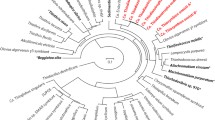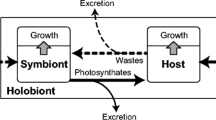Abstract
The gutless marine oligochaetes Phallodrilus leukodermatus and P. planus are known to contain bacteria in their tissues. In this study, we demonstrate that these worms, collected and studied 1982 in Bermuda, contain enzymes characteristic for chemoautotrophic bacteria, as has previously been shown for pogonophorans and some bivalve moliuscs. The enzymes are ribulose-1.5-diphosphate carboxylase (RuBPCase), ATP-sulfurylase, sulfite oxidase and nitrate reductase. Adenosinephosphosulfate reductase and rhodanese could not be detected. In addition, P. leukodermatus was tested for the ability to take up and metabolize radiolabeled bicarbonate and glucose from the surrounding seawater. During incubation periods of up to 6 h. most of the radioactivity administered as bicarbonate was found in malate and succinate; sugars and sugar phosphates were heavily labeled only after short incubation periods of up to 30 min. In comparison to bicarbonate, glucose was taken up from the medium slewly. The quantitative importance of the fixation of bicarbonate versus uptake of dissolved organic matter for the worms' metabolic needs are discussed.
Similar content being viewed by others
Literature cited
Aminuddin, M. and D. J. D. Nicholas: An AMP-independent sulphite oxidase from Thiobacillus denitrificans: purification and properties. J. gen. Microbiol. 82, 103–113 (1974)
Boaden, P. and H. Platt: Daily migration patterns in an intertidal meiobenthic community. Thalassia jugosl. 7, 1–12 (1971)
Cavanaugh, C. M., S. L. Gardiner, M. L. Jones, H. W. Jannasch and J. B. Waterbury: Prokaryotic cells in the hydrothermal vent tube worm Riftia pachyptila Jones: possible chemoautotrophic symbionts. Science, N.Y. 213, 340–342 (1981)
Erseus, C.: Inandrilus bulbosus gen. et sp. n., a marine tubificid (Oligochaeta) from Florida, USA. Zoologica Scr. 8, 209–210 (1979)
Erseus, C. and H. R. Baker: New species of the gutless marine genus Inandrilus (Oligochaeta, Tubificidae) from the Gulf of Mexico and Barbados. Can. J. Zool. 60, 3063–3067 (1982)
Felbeck, H.: Investigations on the role of the amino acids in anaerobic metabolism of the lugworm Arenicola marina. J. comp. Physiol. 137, 183–192 (1980)
Felbeck, H.: Chemoautotrophic potential of the hydrothermal vent tube worm Riftia pachyptila Jones (Vestimentifera). Science, N.Y. 213, 336–338 (1981)
Felbeck, H.: Sulfide oxidation and carbon fixation by the gutless clam Solemya reidi: an animal-bacterial symbiosis. J. comp. Physiol. (In press). (1983)
Felbeck, H., J. J. Childress and G. N. Somero: Calvin-Benson cycle and sulphide oxidation enzymes in animals from sulphide-rich habitats. Nature, Lond. 293, 291–293 (1981)
Felbeck, H., J. J. Childress and G. N. Somero: Biochemical interactions between molluscs and their algal and bacterial symbionts. In: Biochemistry of the Mollusca, Ed. by P. W. Hochachka. New York: Academic Press 2, 331–358 (1983)
Felbeck, H. and G. N. Somero: Primary production in deep-sea hydrothermal vent organisms: roles of sulfide-oxidizing bacteria. Trends biochem. Sci. 7, 201–204 (1982)
Fenchel, T. M. and R. J. Riedl: The sulfide system: a new biotic community underneath the oxidized layer of marine sand bottoms. Mar. Biol. 7, 255–268 (1970)
Giere, O.: Studies on marine Oligochaeta from Bermuda with emphasis on new Phallodrilus-species (Tubificidae). Cah. Biol. mar. 20, 301–314 (1979)
Giere, O.: The gutless marine oligochaete Phallodrilus leukodermatus. Structural studies on an aberrant tubificid associated with bacteria. Mar. Ecol. Prog. Ser. 5, 353–357 (1981)
Giere, O., G. Liebezeit and R. Dawson: Habitat conditions and distribution pattern of the gutless oligochaete Phallodrilus leukodermatus. Mar. Ecol. Prog. Ser. 8, 291–299 (1982)
Hammen, C. S. and S. C. Lum: Carbon dioxide fixation in marine invertebrates. III. The main pathway in flatworms. J. biol. Chem. 237, 2419–2422 (1962)
Hammen, C. S. and P. J. Osborne: Carbon dioxide fixation in marine invertebrates: a survey of major phyla. Science, N.Y. 130, 1409–1410 (1959)
Hausmann, K.: Elektronenmikroskopische Untersuchungen an Anaitides mucosa (Annelida, Polychaeta). Cuticula und Cilien, Schleimzellen und Schleimextrusion. Helgoländer wiss. Meeresunters. 35, 79–96 (1982)
Hope, W. D. and D. G. Murphy: Rhaptothyreus typicus n. g., n.sp., an abyssal marine nematode representing a new family of uncertain taxonomic position. Proc. biol. Soc. Wash. 82, 81–92 (1969)
Jamieson, B. G. M.: Marine meiobenthic Oligochaeta from Heron and Wistari Reefs (Great Barrier Reef) of the genera Clitellio, Limnodriloides and Phallodrilus (Tubificidae) and Grania (Enchytraeidae). Zool. J. Linn. Soc. 61, 329–349 (1977)
Jouin, C.: Description of a free-living polychaete without gut: Astomus taenoides n., gen., n. sp. (Protodrilidae, Archiannelidae). Can. J. Zool. 57, 2448–2456 (1979)
Powell, E. N., M. A. Crenshaw and R. M. Rieger: Adaptations to sulfide in the meiofauna of the sulfide system. 1. 35S-sulfide accumulation and the presence of a sulfide detoxification system. J. exp. mar. Biol. Ecol. 37, 57–76 (1979)
Powell, E. N., M. A. Crenshaw and R. M. Rieger: Adaptations to sulfide in sulfide system meiofauna. End products of sulfide detoxification in three turbellarians and a gastrotrich. Mar. Ecol. Prog. Ser. 2, 169–177 (1980)
Reise, K. and P. Ax: A meiofaunal “thiobios” limited to the anaerobic sulfide system of marine sand does not exist. Mar. Biol. 54, 225–237 (1979)
Richards, K. S., T. P. Fleming and B. G. M. Jamieson: An ultrastructural study of the distal epidermis and the occurrence of subcuticular bacteria in the gutless tubificid Phallodrilus albidus (Oligochaeta: Annelida). Aust. J. Zool. 30, 327–336 (1982)
Saz, H. J.: Facultative anaerobiosis in the invertebrates: pathway and control systems. Am. Zool. 11, 125–135 (1971)
Southward, A. J., E. C. Southward, P. R. Dando, G. H. Rau, H. Felbeck and H. Flügel: Bacterial symbionts and low 13C/12C ratios in tissues of Pogonophora indicate unusual nutrition and metabolism. Nature, Lond. 293, 616–620 (1981)
Southward, E. C.: Bacterial symbionts in Pogonophora. J. mar. biol. Ass. U.K. 62, 889–906 (1982)
Surholt, B.: Production of volatile fatty acids in the anaerobic carbohydrate catabolism of Arenicola marina. Comp. Biochem. Physiol. 58 B, 146–150 (1977)
Wienhausen, G.: Anaerobic formation of acetate in the lugworm Arenicola marina. Naturwissenschaften 68, p. 206 (1981)
Zebe, E.: In-vivo-Untersuchungen über den Glucose-Abbau bei Arenicola marina (Annelida, Polychaeta). J. comp. Physiol. 101, 133–145 (1975)
Zweig, G. and J. Sherma (Eds.): Handbook of chromatography, Vol. 1. 784 pp. Cleveland: CRC Press 1977
Author information
Authors and Affiliations
Additional information
Communicated by N. D. Holland, La Jolla
Rights and permissions
About this article
Cite this article
Felbeck, H., Liebezeit, G., Dawson, R. et al. CO2 fixation in tissues of marine oligochaetes (Phallodrilus leukodermatus and P. planus) containing symbiotic, chemoautotrophic bacteria. Mar. Biol. 75, 187–191 (1983). https://doi.org/10.1007/BF00406001
Accepted:
Issue Date:
DOI: https://doi.org/10.1007/BF00406001




